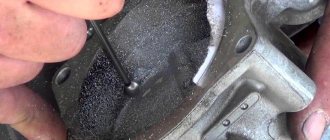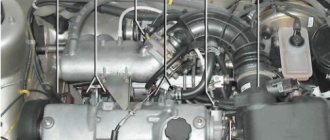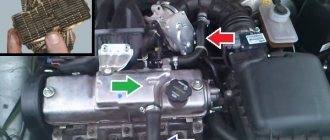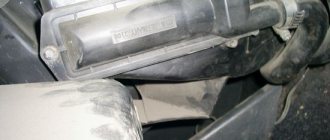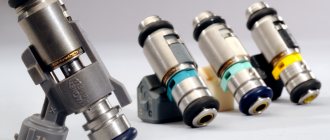During its operation, a gasoline automobile engine (ICE) consumes large volumes of air, using the oxygen contained there to burn fuel. On the path of the air flow to the cylinders there is a number of devices that purify the air, regulate and measure its quantity. One of them is the throttle valve (DZ or simply throttle).
Why does a car need a throttle valve?
The engine does not always need the amount of oxygen that it is able to accept. During one intake stroke, the cylinder will take in a volume of air approximately equal to the product of the area of the piston bottom and its stroke.
If you provide a stroke with the amount of gasoline supplied in a strictly defined proportion to the air, otherwise the mixture simply cannot be ignited, as a result the engine will constantly operate at rated, sometimes called maximum, power. But the driver must regulate the engine output.
On the subject: How an oil pump works, device and malfunctions
There are no other ways other than throttling the air flow in various ways. Therefore, there is a controlled throttle in the intake tract, usually it is just a round-shaped rotary valve in a specially organized throttle assembly.
Various control options are possible depending on individual engine types. Diesel engines, for example, do not need throttles; the fuel will ignite in any case, so the air does not need to be restricted.
Turbocharged gasoline engines can draw more air into the cylinders because it comes under excess pressure, so turbocharging units have their own regulatory limiters, which does not negate the presence of a throttle.
The damper itself can be either mechanically driven by a cable or pedal pull, or electronically controlled by the engine control unit. The principle of operation and possible malfunctions of the remote control look approximately the same in all cases.
What are we talking about?
The throttle valve is one of the main elements of the automotive intake system. It is the damper that is responsible for the metered supply of air, which will be used to prepare the fuel-air mixture. Most budget cars have a simple mechanically driven damper, while more advanced vehicle models are equipped with an electronically controlled device. Since the throttle valve opens and closes frequently, i.e. is constantly in use, it often fails . There are several symptoms here:
- Extremely unstable engine operation “when cold”;
- The Check Engine light comes on (often it lights up, goes out, and so on constantly);
- Loss of traction when trying to gain speed;
- “Floating” speeds at different engine operating modes;
- Abrupt stoppage of engine operation;
- Increased fuel consumption.
As practice shows, some symptoms indicating a throttle valve failure are not so obvious. The failure of this particular mechanism can be correctly determined only by decoding the error or a thorough “live” check by an electrician at a service station. Incomplete diagnostics may indicate a breakdown of the throttle position sensor, EGR , flow meter or other related components.
There is one nuance here: the throttle valve, despite its apparent simplicity, is precisely the mechanism that needs maintenance. Often, regular maintenance saves the car owner from the need to completely change this unit and, in principle, avoids many problems. By maintenance we mean simple cleaning, which even non-professionals can do.
Reasons for dirt getting into the remote control
There are two ways for contaminants to enter the throttle assembly - from the outside, through the air filter, and from inside the engine. In the latter case, it may seem that the dirt cannot move against the powerful air flow. But this is not true, like everything that happens in a piston internal combustion engine, the intake process is cyclical in nature, therefore, the flow continuously pulsates.
Behind the throttle, the intake manifold includes pipelines for crankcase ventilation of the engine and the EGR exhaust recirculation system.
Under certain conditions, foreign inclusions in these gases can also reach the throttle. The temperatures here are high, so hydrocarbons can be deposited on all parts. The geometry of the throttle assembly changes, and difficulties arise in the free movement of the throttle body.
In addition, the module includes an integral part of the idle system. On carburetor engines, these are the metering elements of the carburetor, and on injection engines, these are the idle air regulator (IAC).
It is a separate bypass air channel that bypasses the damper, closed by the regulator valve. The IAC itself is a stepper motor that changes the channel cross-section and is controlled from an electronic unit.
The accuracy of its operation implies the cleanliness of the channel, valve and mechanism of the IAC itself. But dirt gets here in the same way as it does on the walls of the main channel where the damper operates.
When to clean
A dirty throttle valve has similar symptoms to a clogged air filter. Checking and possibly cleaning the throttle body is indicated when observing the following symptoms of vehicle engine behavior:
- uncertain engine start;
- uneven engine operation, floating speed at idle;
- “freezing” of revolutions when releasing the gas pedal;
- when driving at low speed (up to 15 km/h), the car jerks;
- dips appear at around 1000 rpm;
- The car stalls when the clutch is depressed.
The above symptoms are not always associated specifically with the throttle valve or even the air filter. The “culprit” may also be other elements of the fuel system or ignition system. However, it is still necessary to check the throttle valve if such signs are observed.
Signs indicating contamination
As deposits accumulate, the operation of the unit is distorted, which manifests itself in the form of changes in the usual engine modes:
- Narrower idle speed control channels suffer first, which results in unstable operation when the pedal is released;
- Normal operation of the IAC implies a completely closed throttle, but if contamination interferes with this, the system will be unbalanced, which will also affect stability;
- The engine control system is designed for certain parameters of the throttle assembly, where the valve position is monitored by a separate sensor (TPS), and the amount of air is measured by a mass flow or absolute pressure sensor; a discrepancy in the readings will cause interruptions and the inclusion of an error light in the control system;
- In any case, engine output will decrease and consumption will increase;
- The system is especially sensitive in starting mode, so engine start will become uncertain, up to complete failure at low temperatures.
The throttle body should be cleaned regularly so as not to waste excess gasoline, even if the signs of contamination are not yet very pronounced. Reserves of power and starting qualities will hide the initial manifestations of symptoms.
Washing without removal
Some car owners prefer flushing, that is, cleaning the throttle valve using flushing agents without dismantling the assembly itself. As already mentioned, it will most likely not be possible to achieve the desired effect without removing it, however, it would not be a waste, especially if there is no possibility of complete cleaning. For flushing, professional carburetor cleaning aerosols or improvised means (WD-40) are also used.
To wash without removal, you also need to disconnect the air filter pipe. Then, with the damper closed, spray the aerosol on its surface and remove the deposits with a rag. After this, open the damper and treat the side surfaces and channels with a cleaning agent.
How to clean the throttle valve
Hydrocarbon contaminants are quite easily washed off with widely sold carburetor cleaning products, as they are most suitable for dissolving varnishes and resins.
They work very effectively when simply sprayed from an aerosol can, without requiring prolonged soaking, much less the use of hard metal brushes.
Which can harm the mechanics and aerodynamics of the throttle assembly, and therefore are not applicable there. There are also specialized compositions for cleaning chokes; they work in much the same way.
Facilities
Special products are used to remove dirt and build-up. They are aerosol type, sold in cans. Conventionally divided into specialized and universal. The latter can be used to clean carburetors and other car components.
Review of means to clean the throttle valve at home:
- Johnsen 4720. Effectively cleans contaminated surfaces. The advantage is a convenient valve, with which you can perform treatment in hard-to-reach places.
- Hi-Gear. The composition includes anti-corrosion and lubricating components. They do not have a negative effect on the sensitive elements of the unit - oxygen sensor, flexible pipes. However, the manufacturer does not always use a high-quality spray can.
- ZM 08867. Belongs to the category of universal products. One area of application is carburetor cleaning. The advantage is that it contains catalytic converters.
- Mag 1 414. Effectively removes deposits; in addition to this function, it can neutralize organic plaque. Feature: large capacity.
- LIQUI MOLY DrosselKlappen-Reiniger (LM-5111). The manufacturer has developed a composition for cleaning the throttle valve from all types of contaminants.
- Mannol Carburetor Cleaner. Belongs to the category of universal means.
- ABRO Carb&Choke Cleaner (CC-220). Allows you to remove all types of plaque and growths on the surface. The disadvantage is the small capacity of the can (220 ml).
The use of compounds not intended for this work can lead to damage to internal elements. Sometimes the above products are replaced with WD-40, acetone or other solvents. The danger lies in the possible negative impact on sensors and other sensitive components of the unit.
Cleaning instructions
As with all other parts of the car, cleaning is more effective the better access to contaminants is provided. But sometimes the procedure requires efficiency, then it is carried out partially, losing quality.
Cleaning without removal
With a simplified cleaning method, the product is supplied through the air pipe at the inlet to the throttle assembly. It is unacceptable to pass cleaning compounds through the air filter; this will render both the detergent and the filter element unusable.
Cleaning by simply spraying the throttle body and using a rag to wipe off the flowing dirt is ineffective, and most of this product will end up in the engine, which is undesirable.
This is interesting: How to find out the fuel consumption of a car per 100 km
As a last resort, you can use a product that works when the engine is running, while simultaneously cleaning the intake valves. But all these procedures can cause more harm than good, so the unit must be removed for cleaning.
Cleaning the damper by removing the assembly
Disassembly will not take much time; usually the throttle assemblies are easily accessible, and their dismantling is intuitive.
- Before starting work, you need to prepare new gaskets and O-rings for the pipes. Deformation and fatigue changes in the material after the second installation usually cause air leaks, against which the cleaning effect disappears.
- The hoses and pipes are disconnected, the electrical connectors are removed from the sensors and regulators, the throttle assembly is removed from the intake manifold flange.
- The assembly is disassembled further until convenient access to the damper, main and additional channels appears.
- The idle speed control and throttle assembly are washed separately, although if the operation is carried out once every 40-50 thousand kilometers, then it is better not to wash the IAC, but to replace it along with the seal as a preventative measure. It is inexpensive, but can cause a lot of trouble; it will not fail completely, but will cause unpleasant “flickering” phenomena.
- After washing, the unit is purged with clean compressed air.
Sometimes, to remove it, you have to disconnect the coolant hoses that go to the damper heating housing.
They are usually located in the upper part of the cooling system, so a lot of liquid will not be lost, but they should be plugged so as not to drive an air lock into the system.
Cleaning method
the injection system was cleaned during maintenance , the throttle valve most likely did not undergo the cleaning procedure. This point is still worth checking with the master . There are no clear regulations for cleaning the injector and throttle; this should be done at least when the car enthusiast begins to notice malfunctions in the operation of the systems. At the same time, cleaning the throttle valve can be carried out even by an ordinary car enthusiast. Here's what to do:
- To get to the air supply system - turn off the power to the on-board electrical system (remove the negative battery), remove the clamps and pipe that connects the air filter to the throttle, and also disconnect the sensor connector;
- Optional: remove the throttle. This is recommended, however, practice has shown that even if you use a cleaning agent on an installed throttle, problems with the engine do not arise in the future - only the quality of cleaning decreases;
- Spray the cleaning agent onto the entire surface of the throttle valve, leave for 5-10 minutes, blow off and, optionally, wipe with a soft cloth. It is also worth cleaning the well under the regulator. Carburetor cleaner is ideal here.
As some experts note, it is worth cleaning the throttle every 50 thousand km. mileage In this case, it is recommended to dismantle the unit. After complete cleaning, it is worth carrying out preventive maintenance using sprayed products every 20 thousand km (the throttle itself does not need to be removed). We also note that after dismantling the throttle, it makes sense to clean the place where it is installed, as well as install a new gasket . Keep in mind that during dismantling there is a considerable chance of simply breaking the gasket. We recommend keeping at least one gasket in stock even if you clean the mechanism without dismantling it. Sooner or later there will be a need to remove the throttle and completely clean it, and the much-needed gasket will already be on your hands.
An important point: after cleaning the unit, it may begin to work in abnormal mode. The reason may lie either in a malfunction or in the need for adjustment after dismantling. The second problem is almost always observed after cleaning throttle valves with both mechanical and electrical control systems. It is easy to identify the malfunction: immediately after the engine starts, there is a serious increase in speed. In the case of an electronic throttle, the problem is solved as follows:
- Start the engine and let it warm up to operating temperature;
- Silence for 10 seconds;
- Turn on the ignition for exactly 3 seconds;
- Press the accelerator pedal 5 times in 1 second increments;
- Wait another 7 seconds and press the gas until the “Check Engine” light comes on continuously:
- Wait another 3 seconds, release the gas and start the engine.
Spare parts for ZAZ sens
Synchronizer clutch, 5th gear outer race
SENS hatchback (02 — )
Spare parts for Renault 10
Windshield washer fluid 10 sedan (11.65 - 10.71)
If the car is equipped with a mechanically controlled flap, everything is even simpler. It is enough to let the engine idle for about 10 minutes , without turning on additional consumers of electricity (optics, interior lighting, etc.), turn it off, and then start it again and warm it up. After about 200 km, the throttle valve will begin to work as expected. In some cases, it may be necessary to reset the adaptations, although practice shows that on the vast majority of cars the throttle begins to work in normal mode after the above manipulations.
Adaptation of the throttle valve after cleaning and installation
Depending on the vehicle model, a new idle air control valve, as well as a changed throttle body geometry, may require adaptation of parameters within the control system. Although usually the engine does this on its own, unless after the first start the idle speed changes.
The procedure for self-registration is outlined in the repair documentation for a specific engine. Usually a scanner is not required for this; everything is performed by a certain set of manipulations with the ignition switch and the engine, transmission and climate controls.
Sometimes you have to reset incorrect adaptation data of a previously contaminated throttle assembly from the scanner.
Universal multi-brand devices usually contain corresponding sections in the menu that work according to dealer algorithms. After returning to the original settings, the control unit will carry out a new adaptation.
Conclusion
Regular carburetor cleaning ensures that the intake system, and therefore the entire engine, will operate normally in all modes. Often, car enthusiasts attribute problems with increased consumption and poor engine dynamics in different operating modes to an electrical or power unit malfunction. In practice, it often turns out that the problem lies in a heavily contaminated throttle valve, which cannot control the air intake. Fortunately, even an inexperienced car enthusiast can carry out the cleaning. We advise you to keep in mind the fact that the throttle valve is a conditionally repairable element of the intake system and that it requires periodic maintenance.
Necessary tool
Because To most effectively clean the throttle body from oil deposits and dirt, the assembly should be completely removed; the following tools will be useful:
- Phillips and flathead screwdrivers;
- A 13mm spanner or a set of ratchets with heads (for easier dismantling);
- Cleaner for carburetors and throttle valves. It is most convenient to use the “cleaner” in the form of a spray, because... they can reach all throttle cavities;
- Compressor with compressed air (or car pump);
- When dismantling the damper, the old gasket may become unusable, so in case it wears out, purchase a spare gasket.
Note that it will be quite difficult to wash the throttle valve on a VAZ 2114 without special chemicals, because Old oily dirt deposits are very difficult to wash off with plain water.
Important! When cleaning the throttle, do not use metal brushes, sandpaper or a file, as You risk damaging the inner surface of the throttle, which will lead to a loose fit of the valve to the body of the unit.


